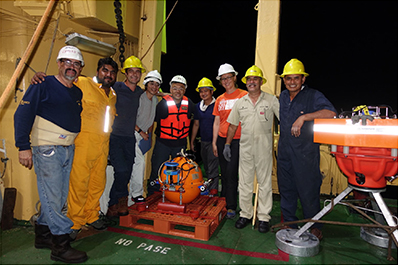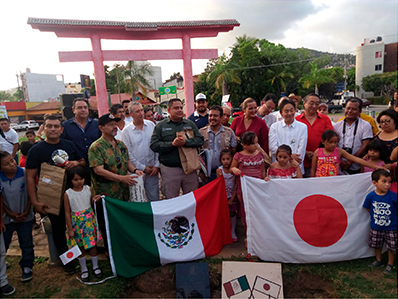MASTER TECHNIQUES from Japan to the World 2
Sharing Lessons from the Great East Japan Earthquake and Japan’s Technologies
—Joint Research with Mexico to Create Readiness against Megathrust Earthquakes—

The research team preparing to install seismometers and pressure recorders (Dr. Cruz Atienza, the main researcher on the Mexican side (third from the left), and Associate Professor Ito of the Disaster Prevention Research Institute, Kyoto University, serving as a representative from Japan (center)) (Photo: Kyoto University)

An event held on the Second World Tsunami Day in the city of Zihuatanejo de Azueta, a targeted city of this project, to commemorate disaster prevention education and bury a time capsule. Capsule to be opened 50 years later in 2067. (Photo: Kyoto University)
Mexico, like Japan, is a country prone to natural disasters. The country is located where earthquakes tend to be triggered by friction instabilities between plates, and is said to be one of the areas with the highest risk of ocean trench megathrust earthquakes and subsequent tsunamis in the world.
The “Project for Hazard Assessment of Large Earthquakes and Tsunamis in the Mexican Pacific Coast for Disaster Mitigation” (SATREPS) Note 1 began in 2016 when Associate Professor ITO Yoshihiro of the Disaster Prevention Research Institute, Kyoto University, proposed cooperating with the National Autonomous University of Mexico (UNAM), with the idea of helping Mexico based on lessons learned from the Great East Japan Earthquake in 2011. Dr. Cruz Atienza, the principal investigator on the Mexican side who has contributed to the development of seismology in Mexico, recalled the situation at that time and said, “Mexico was hit by a magnitude 8.0 earthquake in 1985 and suffered a large amount of damage in and around the capital city. One of the factors was our weakness in assessing risk and preparing countermeasures. Faced with a lack of expertise on undersea earthquakes and tsunamis as well as financial resources, I welcomed this cooperation proposal as the head of the Department of Seismology in UNAM.”
In the State of Guerrero, located on the southern Pacific coast and the subject of this joint research, indications have been identified that megathrust earthquakes and earthquake-triggered tsunamis may occur in the near future. Therefore, it was necessary to carry out more precise observations and to establish highly reliable earthquake/tsunami models based on the observed data. It was also imperative to raise awareness of threats posed by tsunamis among Mexican people with no experience of major tsunami-based damage. To resolve these issues, stakeholders of both countries worked together to promote research and the implementation of research results into society. Dr. Cruz Atienza said, “This project has delivered three major results for Mexico.”
First, this project has established seismic and geodetic networks operating onshore and on the ocean floor. Based on the lessons from the 1985 major earthquake and Japan’s cooperation, Mexico installed seismometers, pressure recorders, and other devices on the ground and on the seafloor for the first time. Japan also shared a variety of know-how such as operation and maintenance of these devices and analysis methods of data obtained from them. Mexican researchers successfully developed new theories and methodologies in geodetic observation, and established powerful data analysis methods.
Second, the project developed and verified hazard maps by simulating earthquakes and earthquake-triggered tsunamis. The tsunami inundation simulation, which was developed based on Japan’s insights, illustrated how far inland a tsunami can reach and how people should evacuate. The Mexican side conducted seismic hazard simulations to quantify the risk in coastal areas. These efforts help inform people of the threat posed by earthquakes and tsunamis and the appropriate actions to take.
Third, the project has also worked with Mexico’s National Center for Disaster Prevention, which was established by Japanese grant aid after the 1985 major earthquake, to develop disaster education programs based on scientific evidence and Mexico’s needs, as well as to introduce these programs to many schools. In developing these education programs, Japan’s expertise in disasters from a psychological aspect was also of great help.
Dr. Cruz Atienza appreciates these significant achievements and says, “We are thankful for the collaboration with great Japanese researchers and funding from Japan. We are now engaged in the next proposal to leverage collaboration results in wider areas.” It is expected that both countries will further enhance collaboration in this area in the future.
Note 1: See the glossary.
<< Previous Page Next Page >>
Main Text | Reference Statistics | Appendix | Stories from the Field | Master Techniques from Japan to the World | ODA Topics
